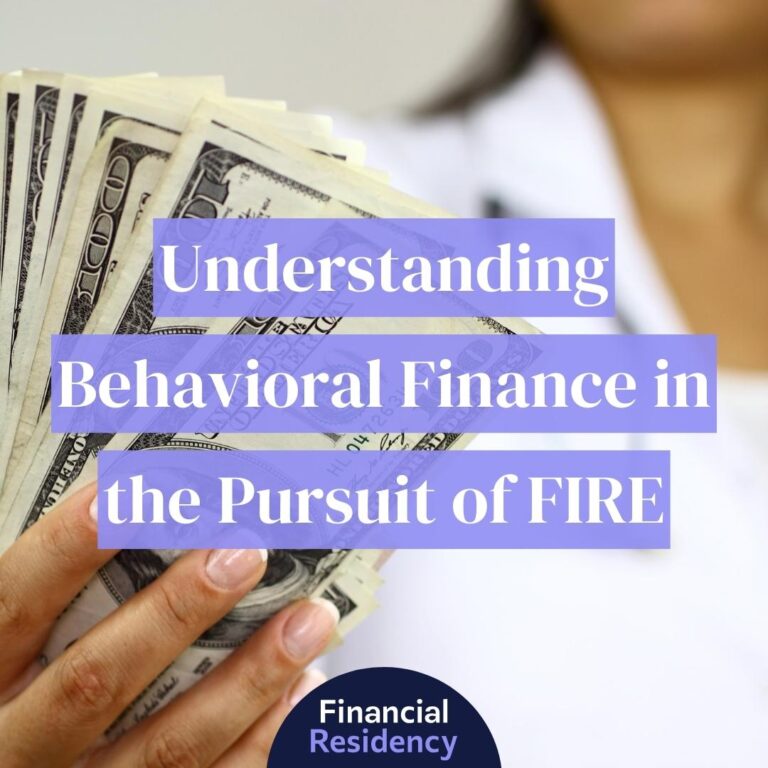You may have heard of the FIRE approach before when listening to Paula Pant or your other favorite financial podcasts. The pithy acronym stands for Financial Independence, Retire Early, and it’s quickly spreading.
It’s an attractive idea, especially for physicians. Many feel burned out in their careers only shortly after they’ve begun. Instead of investing their $400K annual physician salary into a $1 million mortgage, a Tesla, and other trappings of success, they can invest that portion of their earnings in themselves and long-term, early prosperity.
Here’s how the FIRE approach plays out for many physicians: They finish their residencies or fellowships in their late 20s and early 30s and meet with financial planners to figure out monthly expenses and determine their retirement number.
It’s a steady approach that involves mostly frugal living and choosing conservative investment options like index funds. It can take 15 to 25 years to retire using the FIRE approach.
But if 15 to 25 years seems too long to wait, and you’d like to get there in 10 years, or even 5, then the Fast FIRE approach may be for you.
What Is Fast FIRE?
Fast FIRE has the same idea as FIRE — reach financial freedom early and retire well before traditional retirement age — but in a far more accelerated way. Fast FIRE takes the regular FIRE method and pours gasoline on it to achieve an even earlier retirement in a much shorter time frame.
The FAST Fire strategy involves active investment in high-return assets, such as real estate, to accumulate rapid wealth.
Advantages of Fast FIRE
There are many benefits to using the Fast FIRE method.
1. Accelerated Wealth Accumulation
High-income earners like surgeons and physicians can leverage the FAST Fire approach to rapidly accumulate wealth. By adopting an aggressive approach to investing early in your career, you can benefit from significant compound interest and reach your ultimate savings goal much quicker.
Let’s take a look at a scenario. If you were to invest $120,000 a year starting at age 30, by age 40 you could have a sum of $2.22 million. At this figure, the interest alone would have earned you $1.023 million.
Even if you set aside no funds, in 10 more years you would earn an additional $1.63 million in interest, or $3.35 million by the end of 20 years.
In this same scenario, if you began only with $20K, you’d have roughly $744K by the end of 20 years. You’ve missed out on over $2.6 million in earnings just from interest.
Physicians are well-positioned to set aside $120K a year, or other similar aggressive figures. You won’t be able to buy everything you want right now, but you will be able to in the long run — and take a much shorter path to get there.
2. Reduced Financial Stress
While a handsome salary and comfortable lifestyle are major draws to pursuing medicine, doctors are not without financial stress.
Lifestyle creep almost always comes with the job. But if you can remain frugal and live below your means — maintaining the same discipline it took to get through years of medical training — you’ll have greater economic security and peace of mind.
3. Enhanced Career Flexibility
The FAST fire approach offers greater professional flexibility and more career choices. With early financial independence, you can opt to pursue teaching, research, non-profit, or other lesser-paying work.
This also offers you the ability to transition to part-time roles, take sabbaticals, or alter your career in other ways to reduce burnout and increase job satisfaction in a healthcare career.
4. Opportunity for Early Retirement or Career Change
Many doctors would like the ability to change careers or stop practicing medicine. In fact, a recent 2023 Doximity physician study reveals that nearly 86% of doctors feel overworked and 52% are looking to retire early or switch careers as a result of this burnout. However, these doctors feel stuck in their careers due to financial obligations.
The FAST Fire method would enable physicians and surgeons to retire early or to switch career paths. Imagine the freedom of being able to explore other hobbies and interests, or even pursue other university studies or second careers.
5. Legacy and Philanthropic Opportunities
Building significant wealth enables physicians and surgeons to contribute — time and resources — to meaningful philanthropic causes and leave a significant financial legacy for their families.
Here, the FAST Fire approach is not only ensuring your own financial security but meaningfully impacting the economic stability of your family and other individuals.
This is appealing to many doctors, as an intrinsic desire to help others is a major reason for choosing medicine.
How to Fast FIRE
Here’s an outline of the steps needed to adopt the Fast FIRE method.
Step 1: Secure a High-Paying Job
The first step is to secure a high-paying job that pays well above the national average of *$63,795. This is crucial, as it enables you to save and invest large sums of money — and at higher rates than more conservative methods.
Having a high income is foundational for a FAST Fire, as it permits you to cover all your expenses and live comfortably while dedicating a significant portion of your salary to saving and investing.
*Source: Social Security Administration national average wage index for 2022.
Step 2: Hone Your Financial Literacy
Read up on asset planning, investment, and other financial matters. This includes budgeting, savings, investments, and tax strategies to minimize liability.
Building financial literacy will empower you to make better decisions and grow your wealth even faster.
Step 3: Maximize Savings
Maxing out your savings — and getting the best interest and savings rates — is crucial to Fast FIRE. This involves living well below your means.
You may qualify for a $1 million physician mortgage, but what if you bought a $400K home instead? What if you drove a Honda or Toyota instead of a Mercedes-Benz or BMW?
The idea is to save at least 50% of your income, with many experts saying that at least 60% is ideal. This requires a serious commitment to frugal living and keeping a budget, but it’s crucial for obtaining the investment capital needed as a Fast FIRE starter.
You don’t have to go without your dream home or luxury vacations forever; just for right now.
Step 4: Invest Aggressively
Invest your money aggressively. This means looking for high-return and high-risk investment opportunities, as well as diversifying your investments overall to best spread out and manage the risks.
For many physicians who Fast FIRE, this means investing in a mix of assets:
- Stocks
- Bonds
- CDs (practice CD laddering)
- Alternative investments
- Hedge funds
- Stock market index funds
Step 5: Buy Real Estate
Yes, real estate is an asset. But we’re discussing real estate investment as its own step because of its outstanding potential for the concept of Fast FIRE.
Many physicians find tremendous success in rapidly growing their wealth through real estate investments — like Kenji Asakura and Letizia Alto, married physicians who have helped popularize the fast FIRE movement.
Semi-retired doctors, early on in their medical careers they invested heavily in rental property and lived significantly below their means. For them, it has been a reliable, convenient way to build wealth.
And while medical work often gets them out of bed at night, they rarely receive late-night calls to deal with building emergencies — that’s what property manager groups are for. They can handle the heavy (and light) lifting if you provide the capital (or financing).
And even if it is a lot of work upfront, where you manage the property management and landlording, it’s only for a few years until you can outsource that work. Doctors Asakura and Alto see a 25% return on investment through cashflowing rental and currently own 40 units that generate over $250,000 in cash flow.
While other professional property management groups handle finding tenants, repairs, and collecting rent, they can focus on hidden value activities like searching for development projects, supported living investment opportunities, or exchanging properties into larger ones in order to maximize their return.
Step 6: Obtain REPS
It’s extremely beneficial (lucrative) for you or your spouse to obtain real estate professional status (REPS) because of the tax advantages.
Although a physician can use real estate professional status to shelter clinical income, there aren’t many that are doing it. It is a great way for a physician, who is given precious few deductions, to recoup some of their money and rake in the returns.
- Loss deductions: Ability to fully deduct losses from real estate activities.
- Non-passive: Rental portfolio income is considered non-passive income, allowing you to offset any income loss with other sources.
- No NIITs: Avoid the 3.8% net investment income tax (NIIT).
- Greater expertise: Achieving REPS will increase your knowledge base and industry connections, leading to greater success in real estate investment.
- Depreciation benefits: REPS can take advantage of depreciation deductions which can significantly minimize your taxable income.
- Estate planning: Tax-advantaged way to transfer real property.
Real Estate Professional status involves two relatively easy steps—you must spend more than half your time on your real estate business (as a primary profession) and accrue 750+ hours working on the real estate that you personally own and participate in managing.
Step 7: Continuously Optimize Your Finances
Using Fast FIRE isn’t a one-and-done approach. It goes beyond buying your next new property and waiting for the cash to come in.
To be successful, you’ll need to continually optimize your full investment portfolio, always looking for ways to further reduce expenses and increase your income.
While investment is a long game, you still need to be adaptable and make tweaks as market forces and economic landscape change.
Step 8: Plan for Early Retirement
Plan for your early retirement or your early semi-retirement. After achieving financial independence, what does your day-to-day life look like? Who or how will you manage your investments? How will you spend your free time?
You’ll need to develop a strategy to withdraw funds yet continue to support your lifestyle for years to come while not depleting your assets.
Who Should Consider Fast FIRE?
Fast FIRE is an ambitious strategy that’s adaptable for many high-earning professionals who have a high income, financial discipline, and strong personal motivation to meet this aggressive financial goal.
Well-suited occupations include:
- Physicians, surgeons, and other medical professionals
- Corporate executives and business owners
- Lawyers, CPAs, and other legal and financial experts
- Engineers and technology professionals
These occupations are well-suited not just for earning potential but because these professionals generally possess the personal qualities and shared characteristics that are needed to Fast FIRE:
- Discipline: Posses a delayed certification mindset
- High student loan debt: Motivated to eliminate quickly, and the Fast FIRE approach provides a structured way to pay off debt and build long-term wealth
- Career longevity: Demanding occupations have high rates of burnout and Fast FIRE is a viable way to prevent it — practitioners can lessen work hours and adapt conditions for greater longevity
- Skilled learners and doers: Ability to learn and apply complex new concepts that others may find intimidating or ungraspable
In addition to these traits, Fast-Firers must have a high tolerance for risk and be strongly motivated to achieve early financial independence.
Often, this means having a particular goal in mind, like being able to retire early to sail around the world in a yacht or to be a full-time parent to their children.





